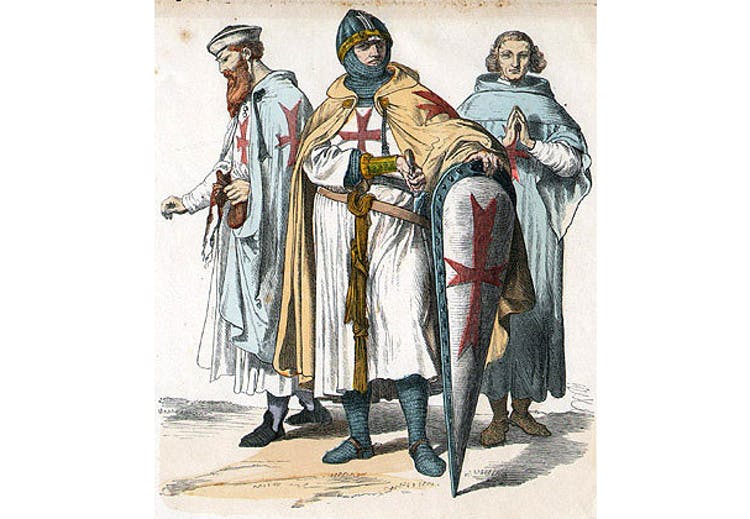Were there Nine Original Templars?
1) Hugues de Payens or Hugo de Paganis (ca 1070–1136), was a Frankish knight from the Champagne Region. Hugh de Payens was a vassal of Hugues I, Count of Champagne. Little information of Hugues de Payens exists and no sources on his later career give details of his early life. Information depends partly on documents that may not refer to the same individual, partly on histories written decades or even centuries after his death. However, Hugh de Payens was a founding member and first Grand Master of the Knights Templar. He created the Latin Rule, the code of behavior for the Order, along with Saint Bernard of Clairvaux. Hugh de Payens left no descendants.
2) Godefroy de Saint-Omer (known also as Geoffroi or Godfrey) was a Flemish knight and a founding member of the Knights Templar in 1129. He is said to have come from the family of the Lords of SaintOmer in Pas-de-Calais, possibly a son of William I de Saint-Omer and Arganitrude de Brugge. Godfrey probably came to Jerusalem in 1099 with William I de Saint-Omer and Hugh de Saint-Omer. According to legend, Godfrey and Hugues de Payens were so poor that between the two of them they had only one horse. This gave rise to the famous image on the seal of the Knights Templar, of two men riding a single horse. Godfrey left no descendants. However, William II de Saint-Omer (possibly Godfrey’s younger brother) and Millesende de Picquigny (great-granddaughter of Templar member Guermond de Picquigny) had a son William III and a daughter Matilda, whose descendants married prominent nobility and English royalty. Many colonial immigrant Americans and their descendants can claim this heritage.
3) André de Montbard (5 Nov. 1097-17 Jan. 1156) came from the Montbard family of Hochadel of Burgundy and was an uncle to Saint Bernard de Clairvaux as half-brother of Bernard’s mother. He was a vassal of Hugues I, Count of Champagne. André de Montbard entered the Order in 1119 and went to Palestine, where he quickly rose to the rank of seneschal and became deputy and second-in-command to
the Grand Master. André de Montbard was elected fifth Grand Master of the Knights Templar on 22 August 1153 to replace Bernard de Tremelay, who had been killed on 16 August during the Siege of Ascalon. He died in Jerusalem on 17 January 1156 and was succeeded by Bertrand de Blanchefort. André de Montbard left no descendants.
4) Hugues I or Hugh (c. 1074 – c.1125), the third son of Theobald II, Count of Blois and Adele of Valois, was known as Count of Champagne although he preferred Count of Troyes. His first recorded act was a monastic gift in 1094, which became the oldest document of the comital archive. However, his grant of lands in 1115 to the monk Bernard de Clairvaux of the reformed Benedictines is the longest remembered. Although Hugh was married twice, he considered himself impotent and never claimed Odo as his son (who left descendants) by his second wife Isabella. Instead, he transferred his titles to his nephew, who became Theobald II of Champagne. Hugh became a Knight Templar in 1125.
5) Geoffroi Bisol was a founding knight of the Knights Templar, but no information was found. Apparently, little is known of his origins.
6) Archambaud de St. Amand was a founding knight of the Knights Templar, but no information was found. Apparently, little is known of his origins.
7) Payen de Montdidier, who was related to the Counts of Flanders and a founding knight of the Knights Templar, established a Preceptory at Oxford, England because of strong support from Queen Matilda. The Queen, wife of Stephen I, King of England (1135-1154) and a niece of Baldwin I of Jerusalem and Godfrey of Bouillon, made Oxford one of the richest and most important centers of the Templars in England. Payen de Montdidier established another Perceptory, Temple Guiting near Cheltenham.
8) Rossal was a monk and a founding member of the Knights Templar, but no other biographical information was found. Apparently, little is known of his origins.
9) Gondemar (Gondamer or Gondemare), a monk of Portuguese origin, was a founding member of the
Templar Knights. Gondemar is listed as one of the Masters of the Knights Templar of Portugal, but no other biographical information was found.
The story of the nine original members of the Knights Templar would not be complete without reference to Warmund de Picquigny (1080-July 1128, known also as Guermond, etc.), a Crusader and Latin Patriarch of Jerusalem (1118-1128). He was Regent of Jerusalem (1123-1124) during the captivity of Baldwin II. Warmund was approached by a group of Christian knights who requested permission to elect a master to lead them to defend the kingdom. Hugues de Payens was chosen as the first master of the Knights Templar. Warmund charged them with the duty of keeping the roads safe from thieves and others who were routinely robbing and killing pilgrims en route to Jerusalem. Warmund de Picquigny’s descendants include Henri I, King of Navarre and his daughter Jeanne, Princess of Navarre who married Philip IV “the Fair” of France (grandparents of Edward III, King of England). Many colonial immigrant Americans and their descendants can claim this heritage.
Or was there closer to 31 original Knights as indicated by Michael the Syrian at this link: https://www.theknightstemplar.org/not-9-templars/ ?

